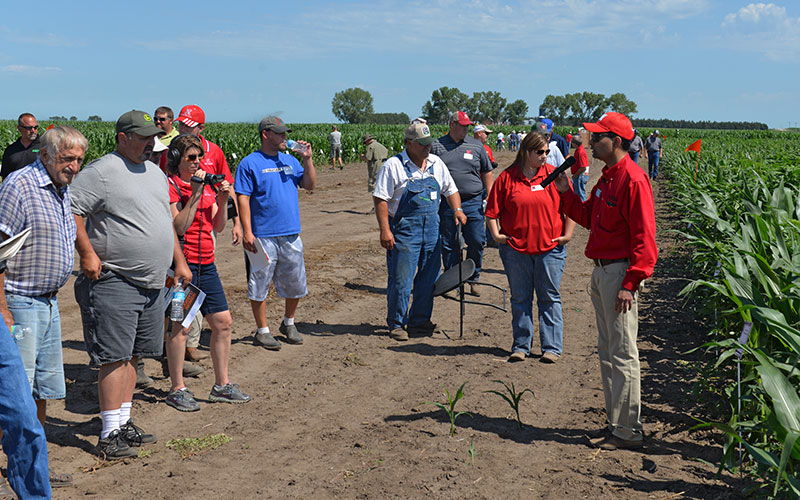
Palmer amaranth, a member of the pigweed (Amaranthaceae) family, is one of the most troublesome weeds in Nebraska corn and soybean fields. Of particular concern is Palmer amaranth resistant to atrazine and HPPD-inhibiting herbicides (Callisto, Laudis, Impact) in south central Nebraska. This is due to its proximity to intense seed corn production, which is primarily reliant on these herbicides for weed control.
Research information was shared with 140 people at the Herbicide-resistant Palmer amaranth Management Field Day July 12 near Shickley, Nebraska. Amit Jhala, University of Nebraska Extension Weed Management Specialist, organized and led the tour. Those in attendance included growers, crop consultants, extension educators, graduate students, industry representatives, and other clientele.
Jason Norsworthy, Professor and Endowed Chair of Weed Science at the University of Arkansas, was the invited speaker for the day. He discussed Palmer amaranth identification, biology, and management in corn and soybean.
Boone McAfee, Director of Research with the Nebraska Corn Board, provided updates on research activities of the Nebraska Corn Board.
Jhala and team members demonstrated several projects for control of herbicide-resistant Palmer amaranth in field and seed corn. They reviewed efficacy, crop safety, and comparison of new herbicides in UNL's unbiased comparison trials. Postdoctoral scientist Debalin Sarangi and graduate students Zahoor Ganie, Ethann Barnes, and Parminder Chahal showed a research project on various aspects of Palmer amaranth biology and control in field and seed corn.
Featured projects included:
– Tank mixing atrazine with Callisto or Balance PRO at different rates for control of resistant Palmer amaranth.
– Tank mixing atrazine with Callisto, Laudis, or Armezone applied post-emergence for control of Palmer amaranth.
– Herbicide programs for resistant Palmer amaranth control in seed corn.
– Management of Palmer amaranth in Roundup Ready Corn and Liberty Link Corn.
– Evaluating programs of Corvus or Balance Flexx followed by DiFlexx in Roundup Ready corn.
– Understanding the effect of tillage on Palmer amaranth emergence.
– Overlapping residual herbicides for Palmer amaranth control in field corn.
The Field Day was a part of the research grant Jhala received from the Nebraska Corn Board. Irvin Schleufer, Sharon Hachtel, Caleb Wilford, Ian Rogers, Megan Drudik, Adam Leise, Jacob Nicodym provided help with registration and tour logistics. Videos will made be available on YouTube of field day presentations. Lunch was provided and followed with UNL Dairy Store ice cream.
More details at: http://go.unl.edu/5key